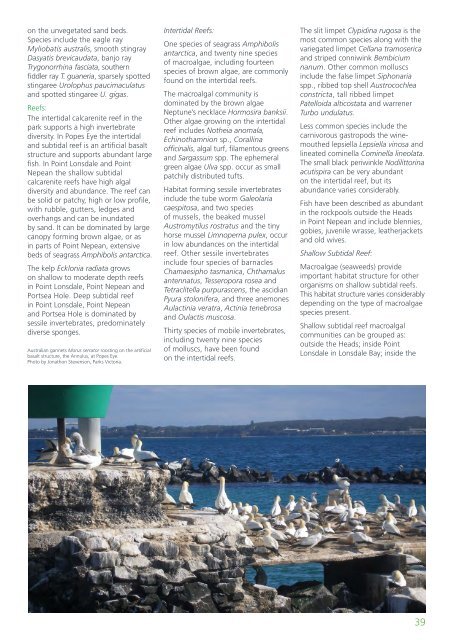Marine Natural Values Study Summary - Parks Victoria
Marine Natural Values Study Summary - Parks Victoria
Marine Natural Values Study Summary - Parks Victoria
Create successful ePaper yourself
Turn your PDF publications into a flip-book with our unique Google optimized e-Paper software.
on the unvegetated sand beds.Species include the eagle rayMyliobatis australis, smooth stingrayDasyatis brevicaudata, banjo rayTrygonorrhina fasciata, southernfiddler ray T. guaneria, sparsely spottedstingaree Urolophus paucimaculatusand spotted stingaree U. gigas.Reefs:The intertidal calcarenite reef in thepark supports a high invertebratediversity. In Popes Eye the intertidaland subtidal reef is an artificial basaltstructure and supports abundant largefish. In Point Lonsdale and PointNepean the shallow subtidalcalcarenite reefs have high algaldiversity and abundance. The reef canbe solid or patchy, high or low profile,with rubble, gutters, ledges andoverhangs and can be inundatedby sand. It can be dominated by largecanopy forming brown algae, or asin parts of Point Nepean, extensivebeds of seagrass Amphibolis antarctica.The kelp Ecklonia radiata growson shallow to moderate depth reefsin Point Lonsdale, Point Nepean andPortsea Hole. Deep subtidal reefin Point Lonsdale, Point Nepeanand Portsea Hole is dominated bysessile invertebrates, predominatelydiverse sponges.Australian gannets Morus serrator roosting on the artificialbasalt structure, the Annulus, at Popes Eye.Photo by Jonathon Stevenson, <strong>Parks</strong> <strong>Victoria</strong>.Intertidal Reefs:One species of seagrass Amphibolisantarctica, and twenty nine speciesof macroalgae, including fourteenspecies of brown algae, are commonlyfound on the intertidal reefs.The macroalgal community isdominated by the brown algaeNeptune’s necklace Hormosira banksii.Other algae growing on the intertidalreef includes Notheia anomala,Echinothamnion sp., Corallinaofficinalis, algal turf, filamentous greensand Sargassum spp. The ephemeralgreen algae Ulva spp. occur as smallpatchily distributed tufts.Habitat forming sessile invertebratesinclude the tube worm Galeolariacaespitosa, and two speciesof mussels, the beaked musselAustromytilus rostratus and the tinyhorse mussel Limnoperna pulex, occurin low abundances on the intertidalreef. Other sessile invertebratesinclude four species of barnaclesChamaesipho tasmanica, Chthamalusantennatus, Tesseropora rosea andTetraclitella purpurascens, the ascidianPyura stolonifera, and three anemonesAulactinia veratra, Actinia tenebrosaand Oulactis muscosa.Thirty species of mobile invertebrates,including twenty nine speciesof molluscs, have been foundon the intertidal reefs.The slit limpet Clypidina rugosa is themost common species along with thevariegated limpet Cellana tramosericaand striped conniwink Bembiciumnanum. Other common molluscsinclude the false limpet Siphonariaspp., ribbed top shell Austrocochleaconstricta, tall ribbed limpetPatelloida alticostata and warrenerTurbo undulatus.Less common species include thecarnivorous gastropods the winemouthedlepsiella Lepsiella vinosa andlineated cominella Cominella lineolata.The small black periwinkle Nodilittorinaacutispira can be very abundanton the intertidal reef, but itsabundance varies considerably.Fish have been described as abundantin the rockpools outside the Headsin Point Nepean and include blennies,gobies, juvenile wrasse, leatherjacketsand old wives.Shallow Subtidal Reef:Macroalgae (seaweeds) provideimportant habitat structure for otherorganisms on shallow subtidal reefs.This habitat structure varies considerablydepending on the type of macroalgaespecies present.Shallow subtidal reef macroalgalcommunities can be grouped as:outside the Heads; inside PointLonsdale in Lonsdale Bay; inside the39
















